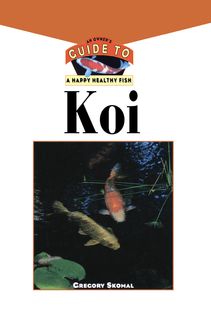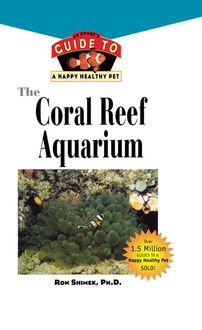The Koi , livre ebook
95
pages
English
Ebooks
2008
Vous pourrez modifier la taille du texte de cet ouvrage
Obtenez un accès à la bibliothèque pour le consulter en ligne En savoir plus
Découvre YouScribe en t'inscrivant gratuitement
Découvre YouScribe en t'inscrivant gratuitement
95
pages
English
Ebooks
2008
Vous pourrez modifier la taille du texte de cet ouvrage
Obtenez un accès à la bibliothèque pour le consulter en ligne En savoir plus
Publié par
Date de parution
05 mai 2008
Nombre de lectures
1
EAN13
9780470368077
Langue
English
Poids de l'ouvrage
2 Mo
Koi: An Owner's Guide To A Happy Healthy Fish gets you started in identifying the many different types of Koi and acquaints you with the many Japanese terms you will need to understand when purchasing fish. Sidebars filled with interesting facts and exceptional color photos make this book easy to read and a visual delight.
PART ONE: The Joy of Koi.
1. What are Koi?
2. Varieties of Koi.
3. Purchasing Koi.
PART TWO: About the Koi Pond.
4. Planning and Building Your Koi Pond.
5. Water Quality and Filtration.
6. Pond Care and Maintenance.
PART THREE: Koi-Keeping.
7. Feeding Your Koi.
8. Koi Health.
9. Breeding Your Koi.
PART FOUR: Beyond the Basics.
10. Glossary of Japanese Koi Terms.
11. Resources.
Publié par
Date de parution
05 mai 2008
Nombre de lectures
1
EAN13
9780470368077
Langue
English
Poids de l'ouvrage
2 Mo
Koi
Howell Book House
Howell Book House An Imprint of Macmillan General Reference USA A Pearson Education Macmillan Company 1633 Broadway New York, NY 10019
Macmillan Publishing books may be purchased for business or sales promotional use. For information please write: Special Markets Department, Macmillan Publishing USA, 1633 Broadway, New York, NY 10019.
Copyright © 1999 by Howell Book House Photography copyright © 1999 by Joyce Glenn unless otherwise noted.
All rights reserved. No part of this book may be reproduced or transmitted in any form or by any means, electronic or mechanical, including photocopying, recording, or by an information storage and retrieval system, without permission in writing from the Publisher.
MACMILLAN is a registered trademark of Pearson Education
Library of Congress Calaloging-in-Publication Data Skomal, Gregory. Koi : an owner’s guide to a happy healthy fish / [Gregory Skomal]. p. cm. Includes bibliographical references. ISBN 1-58245-032-3 1. Koi. I. Title. SF458.K64S56 1999 639.3 7f483—dc21 98-51715 CIP
Manufactured in the United States of America 10 9 8 7 6 5 4 3 2 1
Series Director: Amanda Pisani Series Assistant Director: Michele Matrisciani Book Design: Michele Laseatu Cover Design: Iris Jeromnimon Illustration: Casey Price, Laura Robbins, and Brian Towse Photography:
Front cover by Tom Graham
Inset Courtesy of KOI USA
Laurie Connable: 43, 45, 46, 47, 48, 68, 97
Tom Graham: ii, 5, 10, 11, 15, 17, 18 (top), 19 (top), 20, 21, 23 (top), 25, 30, 32–33, 71, 76–77, 78, 89, 94, 99, 102, 106, 112, 115, 118
KOI USA: 2–3, 16, 24, 27, 31, 104
Production Team: Carrie Allen, Toi Davis, Clint Lahnen, Heather Pope, Carol Sheehan, Dennis Sheehan, and Terri Sheehan
Contents
part one
The Joy of Koi
1 What are Koi?
2 Varieties of Koi
3 Purchasing Koi
part two
About the Koi Pond
4 Planning and Building Your Koi Pond
5 Water Quality and Filtration
6 Pond Care and Maintenance
part three
Koi-Keeping
7 Feeding Your Koi
8 Koi Health
9 Breeding Your Koi
part four
Beyond the Basics
10 Glossary of Japanese Koi Terms
11 Resources
part one
External Features of Koi
chapter 1
What Are Koi?
Considered by many to be the most elegant and colorful of the freshwater fishes, koi have become popular inhabitants of domestic garden ponds. The large size and space requirements of koi preclude their inclusion in the average freshwater aquarium. Therefore, if you want to keep koi, plan on establishing an ornamental or garden pond in an area where you will be able to fully enjoy and maintain your pet koi. This book will provide you with the basics of establishing a pond, properly stocking it with koi, and maintaining, feeding and breeding healthy and attractive fish. But before we move into these areas, let’s first establish exactly what koi are, their origin, morphology and biology.
Koi (which is an adaptation of the formal Japanese name of nishikigoi) are actually just colorful mutations of the common carp, Cyprinus carpio . These carp mutations were first recorded in Persia and China around 2,500 years ago. The Chinese raised carp for food, a practice that was adopted by Japanese rice farmers. Many feel that it was these Japanese farmers of the Niigata Prefecture who noticed colored mutants among the normally drab gray carp. By meticulously selecting these fish and breeding them over many generations, a number of koi varieties were established at that time. Surprisingly, until the twentieth century, koi were only known among these farmers of the Niigata region of Japan. This changed dramatically in the early part of the century when several varieties were exhibited at a Tokyo exhibition. The popularity of this fish rapidly expanded throughout the country and eventually to other parts of the world. Today, koi are bred in North America, western Europe, Israel and Singapore, but the Japanese remain the primary breeders of the world’s finest koi varieties.
THE CYPRINID FAMILY
Koi are one of the 2,000 species of fish that make up the cyprinid family of fish. Many cyprinids are popular fish for the home aquarium, such as the Clown Loach, the Tiger Barb, the Zebra Fish and the Red-Tailed Rasbora. With so many different species, there are obviously many differences between the members of this fish family. One behavior that all cyprinids share is their method of reproduction—cyprinids lay eggs that are then fertilized outside of their body.
Koi belong to the largest family of fishes known as the Cyprinidae, which contains over 2,000 species. The cyprinids have the widest continuous distribution of any freshwater fish family. They are very hardy fish and can generally exist in a wide variety of conditions ranging from quiet vegetated ponds to silty, turbid rivers. They are also capable of tolerating wide temperature fluctuations. A close relative of the koi is another common aquarium inhabitant, the goldfish, Carassius auratus . While koi and goldfish share many common characteristics, koi attain larger sizes and can be readily differentiated from goldfish by the presence of small whiskers or barbels on either side of their mouth.
Although selective breeding has produced a very wide range of morphological varieties of koi, all koi are scientifically classified as a single species, Cyprinus carpio . As a species, all koi possess the same basic external and internal features and general anatomy. They are a fast-growing, large species of fish reaching 7 inches in length at 1 year, 12 inches at 2 years and 16 inches or more at 3 years. Koi can grow as large as 36 inches and weigh over forty-five pounds, but more typically reach 20 to 22 inches in the average ornamental pond. Life expectancy in good environmental conditions can be as long as 50 to 70 years.
Body Form
Koi typically have a rounded body that is fusiform in shape, thickest in the middle and tapered at either end. The body shape of koi makes them excellent swimmers that are capable of fast bursts of speed when they are threatened. However, koi generally swim lazily through the water with an easy-going style.
Koi have a rounded body that is thickest in the middle and tapered at either end. Even though they look a hit like torpedoes, koi tend to swim rather leisurely .
Fins
Almost all species of fish have fins in one form or another. The fins are critically important appendages that allow the fish to propel, stabilize, maneuver and stop. In some cases, fins have developed to protect the fish as well. Again, depending on the type of fish and the habitat it lives in, the fins can take on many shapes and functions.
Koi possess fins that are both medial (unpaired) and lateral (paired). The pectoral fins are the forward-most paired fins. These fins act to help the koi stabilize, turn, rotate, maneuver, hover and swim backward. The pectoral fins are found just behind and below the gills on each side of the fish, under the midline of the body. The pectoral fins are also used to fan the substrate when the fish is foraging for food. The pelvic or ventral fins are also paired and are located on the underside of the fish at the mid-body. In general, the pelvic fins are used for directional changes and enable the fish to move up and down in the water. The single unpaired dorsal fin is located on the top of the koi. This fin is used to stabilize the fish, keeping it upright in the water. The dorsal fin can be lowered to reduce drag during rapid swimming. The anal fin is also unpaired. This fin is located on the underside of the fish, close to the tail behind the anal opening. Like the dorsal fin, the anal fin is used to stabilize the fish during swimming. The caudal or tail fin is an unpaired fin which is largely responsible for propelling the koi forward. This fin is the source of forward momentum for the fish and can also assist in turning and braking. The forked shape of the koi’s tail is indicative of the speed that these fish are capable of attaining.
Koi derive their lovely colors from pigment cells in their skin. The scales are actually translucent and colorless .
Scales
The bodies of koi are typically covered with a large number of small scales, although some varieties have fewer, large scales or no scales at all. The scales are composed of a hard, bony substance and serve to protect the fish, reducing the chance of injuries and infection. Covering the scales is a very thin layer of epidermal tissue that contains mucous cells. These cells produce the slimy texture that we normally attribute to fish. The mucous coating on fish not only protects the koi against injury and infection, but helps the fish swim more easily in the water, reducing the friction between the body and the denser water itself. If the mucous layer is damaged, the koi may develop skin problems and secondary infections.
Skin
The source of the vibrant colors of ornamental koi comes from specialized pigment cells called chromatophore in the dermal layer of the skin. The scales of koi are actually translucent and lack color. The color of the fish depends on the types of chromatophore present. There are generally three types of chromatophore in fish: melanophores, xanthophores and iridophores. Melanophores give fish the darker colors of black, brown and blue; xanthophores produce the colors of red, yellow and orange; and iridophores contain guanine crystals that give the silvery shine common to many koi. Chromatophore are enervated, allowing koi to shift their coloration either lighter or darker. These color changes are generally indicative of stress and should be used to monitor the health of your koi.
Swim Bladder
Living in the dense medium of water presents a few problems for fish, one of which is buoyancy. Maintaining a certain level in the water column without having to expend a lot of energy is very important to fish. Therefore, most species have special organs called swim bladders, and koi are no exception. T







